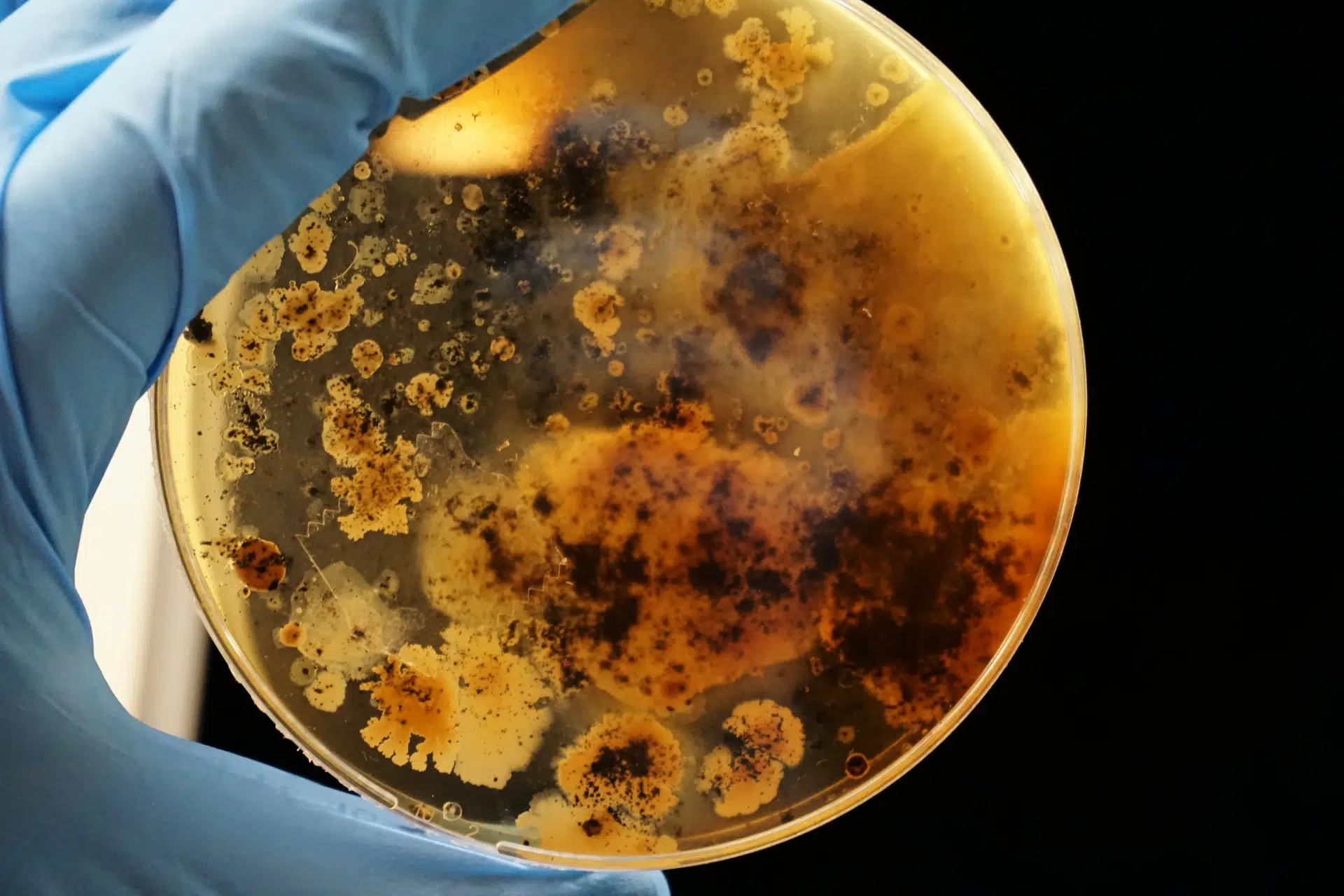Staphylococcus is a normal resident of the skin. It’s a common bacteria that may exist freely in the environment, as a parasite on the skin of the host – and in the upper respiratory tracts of animals. Bacteria may be easily passed from animal to animal and, in rare situations, from animal to human.
Any breed of dog – at any age – can get this infection.
Now, Staphylococcal dermatitis – a bacterial skin infection that causes the skin to become red and inflamed – is the most prevalent kind of staph infection observed in dogs.
One may find this form of bacteria on the skin of dogs and people, where it remains inactive as long as the skin is in good condition. However, if the skin becomes inflamed or wounded, germs can infiltrate the region and cause an infection, which may sometimes represent a severe threat to your dog’s health.
Worried that your pup might have a staph infection?
This article will teach you all you need to know about staphylococcus infections – including how to recognize the early stages of the disease.
About Staphylococcus Bacteria

Staphylococcal bacterium belongs to the Staphylococcus genus, a relatively widespread bacterial genus found in medical clinics, vet clinics, and laboratories worldwide.
Staphylococcal bacteria are present on your and your pet’s skin right now – since they’re part of the body’s normal bacterial flora.
The most well-known species in humans is undoubtedly S. aureus, the bacterium that causes the well-known “Staph” infections that affect individuals – and dogs – of all ages.
Staph aureus may also be found in dogs and cats.
It is, however, less frequent than Staph pseudintermedius, Staph schleiferi, and Staph hyicus. MDR Staph (multidrug-resistant Staph) is a severe disease that affects humans and animals. Many multi-drug resistant Staph can develop resistance to antibiotics.
MRSA Infection In Dogs
When Staph bacteria become “methicillin-resistant,” the number of medicines available to treat them drops dramatically. Because of the difficulties in eliminating infection, Methicillin-resistant Staph aureus (MRSA) is the most well-known of the Staph bacterium.
This bacteria is difficult to treat because it is resistant to many antibiotics and because it contains several virulence characteristics that boost its capacity to destroy bodily tissue and avoid the body’s host defenses. Fortunately, MRSA in dogs is not as common as in people.
Skin infections such as folliculitis, furunculosis, boils, and cellulitis are the most frequent canine staph infection cases.
In addition, Staph infections are often secondary infections. That suggests that something may be interfering with the pet’s skin’s capacity to fight the infection, allowing for a Staph infection to develop.
What Causes Bacteria To Become Resistant To Antibiotics?
When Staph bacterium has a decent area to dwell, they multiply and cause diseases. Now, antibiotics eliminate the majority of staph germs in the dog.
Nevertheless, if even one microbe possesses genes that allow it to survive in the presence of an antibiotic, it will grow and transmit its genes with other bacteria.
Furthermore, if antibiotics are given indefinitely, those staph bacteria will have no competition from other staph strains and become the dog’s primary strain.
If drugs are withdrawn, other staph germs will colonize the skin, but antibiotic resistance genes will be passed along for generations.
And if a different antibiotic is used, another resistant bacterium is picked.
Bacteria share genes that help them survive, leading to the development of bacteria with numerous antibiotic resistance genes.
These bacteria are passed from dog to dog, but they don’t create health problems in most dogs – unless the skin barrier is broken and the dog’s immune system does not clear the infection.
What Causes Staph Infection?
It’s usual to carry staph germs – but it’s not typical to have a staph infection:
Even though staph populates the skin, the immune system and skin barrier prevent germs from entering the skin and causing illness.
Atopic dermatitis and allergic skin disease (skin allergies) cause the skin to become inflamed and irritating, allowing germs to infiltrate the skin and attack it.
A staph infection can develop when a dog licks, scratches, or chews a section of its body – often due to an allergic reaction – to the extent where the skin gets inflamed. As a result, staph skin infections are frequent in many dogs with fleas and those allergic to specific foods, medicines, and environmental factors.
Besides allergies, other common causes are:
- Blood poisoning (bacterial skin infections caused by bacteria or fungi)
- A chronic debilitating diseases
- Seborrhea, skin irritation, or other skin problems
- Hormonal imbalances
- Cut, scrape, or wound that has become infected
- Contaminated substance getting into nose, mouth, or eyes
- Consumption of contaminated substance
- Medical equipment that hasn’t been adequately sterilized
- Immune-related issues
- Other secondary infections
Staph infections can occur in dogs of any breed or age, although older dogs are more vulnerable due to weakened immune systems. Young dogs seem to be at risk, too.
It’s important to understand that while oral antibiotics remove the infection, the staph bacterium may still create an infection again if the underlying cause of the inflammation is not managed properly.
When inflammation is under control, the skin barrier returns to normal or improves significantly, and staph bacterium, while still present on the skin, are less likely to trigger infection.
Symptoms Of Staph Infection
” alt=”older dog at the vet” width=”1642″ height=”1095″ data-lazyloaded=”1″ data-placeholder-resp=”1642×1095″ data-id=”5543″ data-init-width=”1920″ data-init-height=”1280″ data-src=”https://jackspets.com/wp-content/uploads/pexels-mikhail-nilov-7470755.jpg.webp” data-width=”1642″ data-height=”1095″ data-srcset=”/wp-content/uploads/pexels-mikhail-nilov-7470755.jpg.webp 1920w, /wp-content/uploads/pexels-mikhail-nilov-7470755-300×200.jpg.webp 300w, /wp-content/uploads/pexels-mikhail-nilov-7470755-1024×683.jpg.webp 1024w, /wp-content/uploads/pexels-mikhail-nilov-7470755-768×512.jpg.webp 768w, /wp-content/uploads/pexels-mikhail-nilov-7470755-1536×1024.jpg.webp 1536w” data-sizes=”(max-width: 1642px) 100vw, 1642px” />
The signs of a staph skin infection vary depending on which region of the dog’s body is infected.
Bacterial or fungal infections usually cause symptoms near the cut or irritation, but the bacterium can also move to the bloodstream or other parts of the body.
You may notice symptoms of the disease if the infection spreads to internal organs.
Staph infections in dogs can cause the following symptoms:
- Pus filled lesions in and around the wound on the dog’s skin
- Moist skin where the infection occurs
- Inflammation and redness on the dog’s skin
- Fever
- Weakness and lethargy
- Unusual behavior
- Severe discomfort at the wound site
- Wound crusting/scaling that is abnormal
- Itching, gnawing, or licking excessively
- Infections of the eyes, skin, and ears, as well as infections of the upper respiratory tract
- Hair loss
- Loss of appetite
- Rash or red bumps
While we’re at it, there are several types of staph infections:
- Skin conditions include pyoderma and dermatitis.
- Metritis, discospondylitis, encephalitis, osteomyelitis, and cystitis are among diseases that affect the organs.
- Necrotizing fasciitis is a condition that affects the fascia.
How Are Staph Infections In Dogs Diagnosed?
” alt=”skin tests for dogs” width=”1642″ height=”1097″ data-lazyloaded=”1″ data-placeholder-resp=”1642×1097″ data-id=”5544″ data-init-width=”1920″ data-init-height=”1282″ data-src=”https://jackspets.com/wp-content/uploads/karsten-winegeart-uy5l-VJ8dRM-unsplash-1.jpg.webp” data-width=”1642″ data-height=”1097″ data-srcset=”/wp-content/uploads/karsten-winegeart-uy5l-VJ8dRM-unsplash-1.jpg.webp 1920w, /wp-content/uploads/karsten-winegeart-uy5l-VJ8dRM-unsplash-1-300×200.jpg.webp 300w, /wp-content/uploads/karsten-winegeart-uy5l-VJ8dRM-unsplash-1-1024×684.jpg.webp 1024w, /wp-content/uploads/karsten-winegeart-uy5l-VJ8dRM-unsplash-1-768×513.jpg.webp 768w, /wp-content/uploads/karsten-winegeart-uy5l-VJ8dRM-unsplash-1-1536×1026.jpg.webp 1536w” data-sizes=”(max-width: 1642px) 100vw, 1642px” />
Two staphylococcal lesions are common.
One form starts as a red spot on the skin with a pustule in the middle, similar to a pimple.
The other form is a round, reddish region with a crusty border and hair loss in the center. The latter is readily mistaken for ringworm or yeast skin infection.
The presence of either of these skin patterns in a scratching dog strongly suggests staphylococcal dermatitis.
Skin tests – such as a skin swab or a skin biopsy – can be used to confirm the diagnosis along with microscopic examination. The skin swab and skin biopsy confirm the organism’s identity and help antibiotic susceptibility testing to choose the best treatment.
What’s more, the Staph bacterium may also cause infections in nearly every major organ.
Staph infections of the urinary tract are characterized by discomfort while urinating, bloody urine (hematuria), and murky, brownish, foul-smelling urine.
A veterinarian may also do a complete physical examination and ask for a pet’s medical history, a urine sample for culture, microscopic analysis, complete blood count, or other tests if necessary.
Moreover, Staph can infect the disks between vertebrae in the spinal column, as well as the bone itself, in rare circumstances. That results in severe discomfort and temperature, edema, and loss of weight.
Tremors and dizziness may emerge if the inflammation is severe enough to pressure the spinal cord. The vet may request X-rays, a spinal tap, or blood cultures to make a conclusive diagnosis.
Treatment Of Staph Infection In Dogs
Treatment depends on the type of staph infection. Oral antibiotic medicine is usually used to treat a staph infection. Your veterinarian may also recommend a topical treatment or an antibacterial shampoo if the staph infection is on the puppy’s skin.
Treatment may take three to six weeks to get the illness under control. Infections caused by Staphylococcus can be spread from dog to dog and from dog to person – so, take precautions while touching and treating your dog.
Inform your vet about any drugs or supplement your pup is using so they may create the perfect treatment option for your pet’s situation and decrease the possibility of a drug interaction.
Note:Stopping the loop of itching and scratching – which may have led to the staphylococcal infection – is also an essential element of treatment. Other tests may be required to pinpoint the source of the irritation since itching is often caused by a combination of factors.
Recovery Process
Most Staph infections of the skin typically cure entirely in a couple of days or weeks if the owner provides the medicine as indicated and the pet is kept in proper warm, hygienic circumstances.
In rare cases, an illness may be immune to a single antibiotic – as I mentioned above – necessitating the use of numerous medicines.
Antibiotics alone can’t prevent infection from causing harm to organ structures and surrounding tissue. Therefore, the prognosis for internal infections is less promising.
In most situations, though, there is a good possibility of recovery with the proper therapy indicated by a veterinarian.


